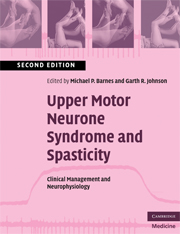Book contents
- Frontmatter
- Contents
- List of Contributors
- Preface to the second edition
- 1 An overview of the clinical management of spasticity
- 2 Neurophysiology of spasticity
- 3 The measurement of spasticity
- 4 Physiotherapy management of spasticity
- 5 Seating and positioning
- 6 Orthoses, splints and casts
- 7 Pharmacological management of spasticity
- 8 Chemical neurolysis in the management of muscle spasticity
- 9 Spasticity and botulinum toxin
- 10 Intrathecal baclofen for the control of spinal and supraspinal spasticity
- 11 Surgical management of spasticity
- 12 Management of spasticity in children
- Index
- References
8 - Chemical neurolysis in the management of muscle spasticity
Published online by Cambridge University Press: 22 August 2009
- Frontmatter
- Contents
- List of Contributors
- Preface to the second edition
- 1 An overview of the clinical management of spasticity
- 2 Neurophysiology of spasticity
- 3 The measurement of spasticity
- 4 Physiotherapy management of spasticity
- 5 Seating and positioning
- 6 Orthoses, splints and casts
- 7 Pharmacological management of spasticity
- 8 Chemical neurolysis in the management of muscle spasticity
- 9 Spasticity and botulinum toxin
- 10 Intrathecal baclofen for the control of spinal and supraspinal spasticity
- 11 Surgical management of spasticity
- 12 Management of spasticity in children
- Index
- References
Summary
Introduction
Destruction of peripheral nerves with chemical substances such as phenol and alcohol solutions (chemical neurolysis) was introduced as a novel therapeutic modality in the 1930s, but it became a popular method of treatment of severe, intractable pain associated with cancer in the mid-1950s (Maher, 1955; Brown, 1958). A few years later peripheral nerve blocks with local anaesthetics and neurolytic agents were found to be effective in the management of muscle spasticity and neurogenic bladder disorders and more recently they have also been used to predict the outcome of certain surgical procedures such as selective dorsal rhizotomy.
An important therapeutic use of peripheral nerve and intrathecal blocks is in the treatment of severe or intractable pain (e.g. pain associated with cancer and with trigeminal and postherpetic neuralgia). Complete symptomatic relief is achieved in more than 70% of patients with chronic pain due to neurogenic causes or ischaemia (Hatangdi & Boas, 1975). Nerve blocks have also been shown to be valuable in the management of bladder dysfunction due to spinal cord injury or disease. The selective chemical denervation of S3 sacral segment in patients with a hyperactive detrusor muscle increases bladder capacity and reduces the uninhibited contractions. Continence is usually achieved in these patients without sphincter disturbances or sexual dysfunction (Torrens, 1974; Rockswold & Bradley, 1977). In addition, chemical neurolysis has proved to be an effective intervention in the management of severe upper and lower limb muscle spasticity.
Keywords
- Type
- Chapter
- Information
- Upper Motor Neurone Syndrome and SpasticityClinical Management and Neurophysiology, pp. 150 - 164Publisher: Cambridge University PressPrint publication year: 2008
References
- 4
- Cited by

